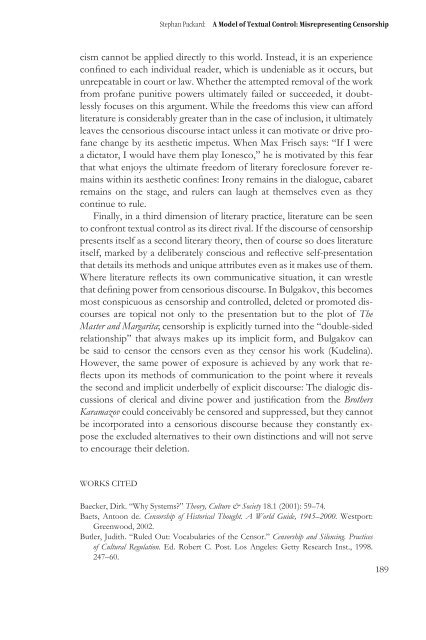- Page 1:
Literatura in cenzuraKdo se boji re
- Page 5:
Marijan Dović:Literatura in cenzur
- Page 9 and 10:
Marijan Dović:Literatura in cenzur
- Page 11 and 12:
Totalitarna in post-totalitarnacenz
- Page 13 and 14:
Marijan Dović:Totalitarna in post-
- Page 16:
Literatura in cenzura: kdo se boji
- Page 19 and 20:
Marijan Dović:Totalitarna in post-
- Page 21 and 22:
Marijan Dović:Totalitarna in post-
- Page 27 and 28:
Stephan Packard:Model tekstualnega
- Page 29:
Stephan Packard:Model tekstualnega
- Page 33:
Stephan Packard:Model tekstualnega
- Page 36 and 37:
Literatura in cenzura: kdo se boji
- Page 38:
Literatura in cenzura: kdo se boji
- Page 43:
II.Kontroverze totalitarne cenzure
- Page 46 and 47:
Literatura in cenzura: kdo se boji
- Page 48 and 49:
Literatura in cenzura: kdo se boji
- Page 50 and 51:
Literatura in cenzura: kdo se boji
- Page 52 and 53:
Literatura in cenzura: kdo se boji
- Page 54 and 55:
Literatura in cenzura: kdo se boji
- Page 56 and 57:
Literatura in cenzura: kdo se boji
- Page 58 and 59:
Literatura in cenzura: kdo se boji
- Page 60 and 61:
Literatura in cenzura: kdo se boji
- Page 62 and 63:
Literatura in cenzura: kdo se boji
- Page 64 and 65:
Literatura in cenzura: kdo se boji
- Page 66 and 67:
Literatura in cenzura: kdo se boji
- Page 68 and 69:
Literatura in cenzura: kdo se boji
- Page 70 and 71:
Literatura in cenzura: kdo se boji
- Page 72 and 73:
Literatura in cenzura: kdo se boji
- Page 74 and 75:
Literatura in cenzura: kdo se boji
- Page 76 and 77:
Literatura in cenzura: kdo se boji
- Page 78 and 79:
Literatura in cenzura: kdo se boji
- Page 81 and 82:
Cenzura in dramske strategijev jugo
- Page 83 and 84:
Aleksandra Jovićević: Cenzura in
- Page 85 and 86:
Aleksandra Jovićević: Cenzura in
- Page 87 and 88:
Aleksandra Jovićević: Cenzura in
- Page 89 and 90:
Aleksandra Jovićević: Cenzura in
- Page 91 and 92:
Aleksandra Jovićević: Cenzura in
- Page 93 and 94:
Aleksandra Jovićević: Cenzura in
- Page 95:
III.Post-totalitarna cenzura
- Page 98 and 99:
Literatura in cenzura: kdo se boji
- Page 100 and 101:
Literatura in cenzura: kdo se boji
- Page 102 and 103:
Literatura in cenzura: kdo se boji
- Page 105 and 106:
Slačenje literarne zgodovine:cenzu
- Page 107 and 108:
Andrej Zavrl:Slačenje literarne zg
- Page 109 and 110:
Andrej Zavrl:Slačenje literarne zg
- Page 111 and 112:
Andrej Zavrl:Slačenje literarne zg
- Page 113 and 114:
Andrej Zavrl:Slačenje literarne zg
- Page 115:
Andrej Zavrl:Slačenje literarne zg
- Page 118 and 119:
Literatura in cenzura: kdo se boji
- Page 120 and 121:
Literatura in cenzura: kdo se boji
- Page 122 and 123:
Literatura in cenzura: kdo se boji
- Page 124 and 125:
Literatura in cenzura: kdo se boji
- Page 126 and 127:
Literatura in cenzura: kdo se boji
- Page 128 and 129:
Literatura in cenzura: kdo se boji
- Page 130 and 131:
Literatura in cenzura: kdo se boji
- Page 132 and 133:
Literatura in cenzura: kdo se boji
- Page 134 and 135:
Literatura in cenzura: kdo se boji
- Page 136 and 137:
Literatura in cenzura: kdo se boji
- Page 138 and 139:
Literatura in cenzura: kdo se boji
- Page 140 and 141: Literatura in cenzura: kdo se boji
- Page 142 and 143: Literatura in cenzura: kdo se boji
- Page 144 and 145: Literatura in cenzura: kdo se boji
- Page 146 and 147: Literatura in cenzura: kdo se boji
- Page 148 and 149: Literatura in cenzura: kdo se boji
- Page 150 and 151: Obsojena pisatelja
- Page 152 and 153: Literatura in cenzura: kdo se boji
- Page 154 and 155: Literatura in cenzura: kdo se boji
- Page 156 and 157: O AVTORJIHSalah Salim Ali je študi
- Page 158 and 159: Breda Smolnikar, pisateljica in pre
- Page 161 and 162: Literature and Censorship, Truthand
- Page 163 and 164: Marijan Dović:Literature and Censo
- Page 165 and 166: Marijan Dović:Literature and Censo
- Page 167 and 168: Marijan Dović:Literature and Censo
- Page 169 and 170: Totalitarian and Post-totalitarianC
- Page 171 and 172: Marijan Dović:Totalitarian and Pos
- Page 173 and 174: Marijan Dović:Totalitarian and Pos
- Page 175: Marijan Dović:Totalitarian and Pos
- Page 178 and 179: Literature and Censorship: Who is A
- Page 180 and 181: Literature and Censorship: Who is A
- Page 182 and 183: Literature and Censorship: Who is A
- Page 184 and 185: Literature and Censorship: Who is A
- Page 186 and 187: Literature and Censorship: Who is A
- Page 188 and 189: Literature and Censorship: Who is A
- Page 192 and 193: Literature and Censorship: Who is A
- Page 194 and 195: Literature and Censorship: Who is A
- Page 196 and 197: Literature and Censorship: Who is A
- Page 198 and 199: Literature and Censorship: Who is A
- Page 200 and 201: Literature and Censorship: Who is A
- Page 202 and 203: II. Controversies of TotalitarianCe
- Page 204 and 205: Literature and Censorship: Who is A
- Page 206 and 207: Literature and Censorship: Who is A
- Page 208 and 209: Literature and Censorship: Who is A
- Page 210 and 211: Literature and Censorship: Who is A
- Page 212 and 213: Literature and Censorship: Who is A
- Page 214 and 215: Literature and Censorship: Who is A
- Page 216 and 217: Literature and Censorship: Who is A
- Page 218 and 219: Literature and Censorship: Who is A
- Page 220 and 221: Literature and Censorship: Who is A
- Page 222 and 223: Literature and Censorship: Who is A
- Page 224 and 225: Literature and Censorship: Who is A
- Page 226 and 227: Literature and Censorship: Who is A
- Page 228 and 229: Literature and Censorship: Who is A
- Page 230 and 231: Literature and Censorship: Who is A
- Page 232 and 233: Literature and Censorship: Who is A
- Page 234 and 235: Literature and Censorship: Who is A
- Page 236 and 237: Literature and Censorship: Who is A
- Page 238 and 239: Literature and Censorship: Who is A
- Page 240 and 241:
Literature and Censorship: Who is A
- Page 242 and 243:
Literature and Censorship: Who is A
- Page 244 and 245:
Literature and Censorship: Who is A
- Page 246 and 247:
Literature and Censorship: Who is A
- Page 248 and 249:
Literature and Censorship: Who is A
- Page 250 and 251:
Literature and Censorship: Who is A
- Page 252 and 253:
III.Post-totalitarian censorship
- Page 254 and 255:
Literature and Censorship: Who is A
- Page 256 and 257:
Literature and Censorship: Who is A
- Page 258 and 259:
Literature and Censorship: Who is A
- Page 260 and 261:
Literature and Censorship: Who is A
- Page 262 and 263:
Literature and Censorship: Who is A
- Page 264 and 265:
Literature and Censorship: Who is A
- Page 266 and 267:
Literature and Censorship: Who is A
- Page 268 and 269:
Literature and Censorship: Who is A
- Page 270 and 271:
Literature and Censorship: Who is A
- Page 273 and 274:
Untimely Rewriting: Memoryand Self-
- Page 275 and 276:
Peter Dunwoodie:Untimely Rewriting:
- Page 277 and 278:
Peter Dunwoodie:Untimely Rewriting:
- Page 279 and 280:
Peter Dunwoodie:Untimely Rewriting:
- Page 281 and 282:
Peter Dunwoodie:Untimely Rewriting:
- Page 283:
Peter Dunwoodie:Untimely Rewriting:
- Page 286 and 287:
Literature and Censorship: Who is A
- Page 288 and 289:
Literature and Censorship: Who is A
- Page 290 and 291:
Literature and Censorship: Who is A
- Page 292 and 293:
Literature and Censorship: Who is A
- Page 294 and 295:
Literature and Censorship: Who is A
- Page 297 and 298:
Words in FreedomSimona ŠkrabecBarc
- Page 299 and 300:
Simona Škrabec:Words in Freedomnow
- Page 301 and 302:
Simona Škrabec:Words in Freedomof
- Page 303 and 304:
Simona Škrabec:Words in Freedoming
- Page 305 and 306:
Simona Škrabec:Words in FreedomRea
- Page 307 and 308:
Simona Škrabec:Words in Freedomrea
- Page 309:
Convicted Writers
- Page 312 and 313:
Literature and Censorship: Who is A
- Page 315 and 316:
A Dream Napkin White as Snowon the
- Page 317 and 318:
Breda Smolnikar:A Dream Napkin Whit
- Page 319 and 320:
Louise L. Lambrichs is a French nov
















